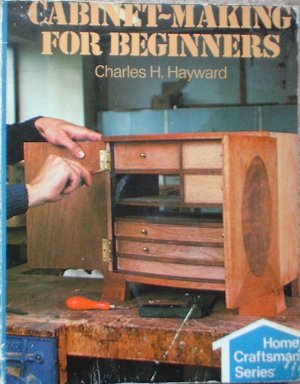

| Publisher | Sterling Publishing Co. |
| Year | 1979 revision |
| ISBN | 0-8069-8184-9 |
| Pages | 128 |
Ken Greenberg
This is an entertaining little book that serves as a general introduction to many topics that are of interest to hand tool woodworkers. It does have a unique (or at least unusual) perspective in that it is a reflection of the time in which it was written - 1947, although this review is of a modern revision. At that point in time, the author reports that high-quality hardwood was becoming scarce and thus there is a significant emphasis on plywood, chipboard, and other manufactured wood products. This is an interesting contrast with earlier books (The Complete Woodworker, for example) that do not address such special needs. As the title suggests, the focus here is specifically on cabinetmaking. Certainly the skills associated with the construction of cabinetry have wide application. By eliminating other woodworking topics such as box making, kitchen cabinetry, chairs and tables, garden sheds (and in the case of Mr. Jones, airplanes), the author manages to convey a good deal of information in a book that most people could consume in a night or two.
As has been occasionally pointed out, the idea that this book is for beginners should not be taken too seriously. There is a good deal of information that is of interest to woodworkers at every skill level, and any book that contains correct information is certainly worth reading. Who among us can't learn something new from any book on the subject? Indeed, the section on joinery alone is sufficiently comprehensive that if you mastered all the joints in this book, you would be well ahead of many skilled woodworkers.
Hayward starts out with a chapter on tools - saws, planes, chisels, boring tools, and so on. His tool kit list would equip a shop to do the kind of work he covers, and he points out which tools can be acquired on an as-needed basis. While some of us might have a broader selection of tools available, one could get by quite well with Hayward's selection. Remember that he was working in an era when decoration was quite simple. Partly as a result of the focus on manufactured materials, he does specify a few power tools. As he points out, chipboard doesn't plane well and sawing is probably the best strategy for working with it.
He then moves on to joinery, and covers pretty much every joint you would need to know. Most of these are the standard joints used in solid wood construction, including frame-and-panel designs. He concludes with a small section on joints appropriate to man-made materials. He then moves on to cabinet construction, which includes more information on joinery. Clearly, the two subjects are closely related although covered in separate chapters. An entire chapter is devoted to doors (remember, these are cabinet doors, not house doors) including such specialized topics as tambour doors. A chapter on drawer making follows.
With the construction covered, Hayward next addresses veneering in some detail. Since his view is that the days of nice wood are pretty much over (thankfully, this proved to be a bit premature), veneering is a topic of some emphasis. He then includes a chapter on fittings: hinges, locks, catches, and the like. Some of these seem a bit obscure, but most are still readily available. Even screws and nails are addressed. He concludes with a chapter on drawing, addressing the issue of getting used to metric scales. There is a short section on building a bookcase in oak at the end of the book, which is probably an attempt to pull all of the knowledge in the book together in one project.
In summary, I think this is a worthwhile book to have around, especially for those who feel they have a good deal to learn and just need some guidance on how to get started in cabinetry. The book is readily available as a used paperback - I think I paid $1.99 for mine.